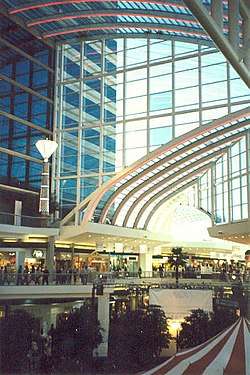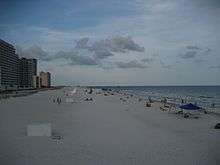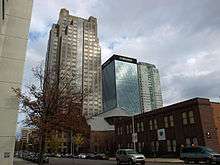Economy of Alabama
The state of Alabama has invested in aerospace, education, health care, banking, and various heavy industries, including automobile manufacturing, mineral extraction, steel production and fabrication. By 2006, crop and animal production in Alabama was valued at $1.5 billion. In contrast to the primarily agricultural economy of the previous century, this was only about 1% of the state's gross domestic product. The number of private farms has declined at a steady rate since the 1960s, as land has been sold to developers, timber companies, and large farming conglomerates.[1]

Non-agricultural employment in 2008 was 121,800 in management occupations; 71,750 in business and financial operations; 36,790 in computer-related and mathematical occupation; 44,200 in architecture and engineering; 12,410 in life, physical, and social sciences; 32,260 in community and social services; 12,770 in legal occupations; 116,250 in education, training, and library services; 27,840 in art, design and media occupations; 121,110 in healthcare; 44,750 in fire fighting, law enforcement, and security; 154,040 in food preparation and serving; 76,650 in building and grounds cleaning and maintenance; 53,230 in personal care and services; 244,510 in sales; 338,760 in office and administration support; 20,510 in farming, fishing, and forestry; 120,155 in construction and mining, gas, and oil extraction; 106,280 in installation, maintenance, and repair; 224,110 in production; and 167,160 in transportation and material moving.[2]

According to the U.S. Bureau of Economic Analysis, the 2008 total gross state product was $170 billion, or $29,411 per capita. Alabama's 2012 GDP increased 1.2% from the previous year. The single largest increase came in the area of information.[3] In 2010, per capita income for the state was $22,984.[4]
The state's seasonally adjusted unemployment rate was 5.8% in April 2015.[5] This compared to a nationwide seasonally adjusted rate of 5.4%.[6]
Alabama has no state minimum wage and uses the federal minimum wage of $7.25. In February 2016, the state passed legislation that prevents Alabama municipalities from raising the minimum wage in their locality. The legislation voids a Birmingham city ordinance that was to raise the city's minimum wage to $10.10.[7]
As of 2018, Alabama has the sixth highest poverty rate among states in the U.S.[8] In 2017, United Nations Special Rapporteur Philip Alston toured parts of rural Alabama and observed environmental conditions that he said were poorer than anywhere he had seen in the developed world.[9]
Largest employers



The five employers that employed the most employees in Alabama in April 2011 were:[10]
| Employer | Employees |
|---|---|
| Redstone Arsenal | 25,373 |
| University of Alabama at Birmingham (includes UAB Hospital) | 18,750 |
| Maxwell Air Force Base | 12,280 |
| State of Alabama | 9,500 |
| Mobile County Public School System | 8,100 |
The next twenty largest employers, as of 2011, included:[11]
| Employer | Location |
|---|---|
| Anniston Army Depot | Anniston |
| AT&T | Multiple |
| Auburn University | Auburn |
| Baptist Medical Center South | Montgomery |
| Birmingham City Schools | Birmingham |
| City of Birmingham | Birmingham |
| DCH Health System | Tuscaloosa |
| Huntsville City Schools | Huntsville |
| Huntsville Hospital System | Huntsville |
| Hyundai Motor Manufacturing Alabama | Montgomery |
| Infirmary Health System | Mobile |
| Jefferson County Board of Education | Birmingham |
| Marshall Space Flight Center | Huntsville |
| Mercedes-Benz U.S. International | Vance |
| Montgomery Public Schools | Montgomery |
| Regions Financial Corporation | Multiple |
| Boeing | Multiple |
| University of Alabama | Tuscaloosa |
| University of South Alabama | Mobile |
| Walmart | Multiple |
Agriculture
Alabama's agricultural outputs include poultry and eggs, cattle, fish, plant nursery items, peanuts, cotton, grains such as corn and sorghum, vegetables, milk, soybeans, and peaches. Although known as "The Cotton State", Alabama ranks between eighth and tenth in national cotton production, according to various reports,[12][13] with Texas, Georgia and Mississippi comprising the top three.
Industry
Alabama's industrial outputs include iron and steel products (including cast-iron and steel pipe); paper, lumber, and wood products; mining (mostly coal); plastic products; cars and trucks; and apparel. In addition, Alabama produces aerospace and electronic products, mostly in the Huntsville area, the location of NASA's George C. Marshall Space Flight Center and the U.S. Army Materiel Command, headquartered at Redstone Arsenal.

A great deal of Alabama's economic growth since the 1990s has been due to the state's expanding automotive manufacturing industry. Located in the state are Honda Manufacturing of Alabama, Hyundai Motor Manufacturing Alabama, Mercedes-Benz U.S. International, and Toyota Motor Manufacturing Alabama, as well as their various suppliers. Since 1993, the automobile industry has generated more than 67,800 new jobs in the state. Alabama currently ranks 4th in the nation for vehicle exports.[14]
Automakers accounted for approximately a third of the industrial expansion in the state in 2012.[15] The eight models produced at the state's auto factories totaled combined sales of 74,335 vehicles for 2012. The strongest model sales during this period were the Hyundai Elantra compact car, the Mercedes-Benz GL-Class sport utility vehicle and the Honda Ridgeline sport utility truck.[16]

Steel producers Outokumpu, Nucor, SSAB, ThyssenKrupp, and U.S. Steel have facilities in Alabama and employ over 10,000 people. In May 2007, German steelmaker ThyssenKrupp selected Calvert in Mobile County for a 4.65 billion combined stainless and carbon steel processing facility.[17] ThyssenKrupp's stainless steel division, Inoxum, including the stainless portion of the Calvert plant, was sold to Finnish stainless steel company Outokumpu in 2012.[18] The remaining portion of the ThyssenKrupp plant had final bids submitted by ArcelorMittal and Nippon Steel for $1.6 billion in March 2013. Companhia Siderúrgica Nacional submitted a combined bid for the mill at Calvert, plus a majority stake in the ThyssenKrupp mill in Brazil, for $3.8 billion.[19] In July 2013, the plant was sold to ArcelorMittal and Nippon Steel.[20]
The Hunt Refining Company, a subsidiary of Hunt Consolidated, Inc., is based in Tuscaloosa and operates a refinery there. The company also operates terminals in Mobile, Melvin, and Moundville.[21] JVC America, Inc. operates an optical disc replication and packaging plant in Tuscaloosa.[22]
The Goodyear Tire and Rubber Company operates a large plant in Gadsden that employs about 1,400 people. It has been in operation since 1929.
Construction of an Airbus A320 family aircraft assembly plant in Mobile was formally announced by Airbus CEO Fabrice Brégier from the Mobile Convention Center on July 2, 2012. The plans include a $600 million factory at the Brookley Aeroplex for the assembly of the A319, A320 and A321 aircraft. Construction began in 2013, with plans for it to become operable by 2015 and produce up to 50 aircraft per year by 2017.[23][24] The assembly plant is the company's first factory to be built within the United States.[25] It was announced on February 1, 2013, that Airbus had hired Alabama-based Hoar Construction to oversee construction of the facility.[26]
Tourism and entertainment

Tourism is a strong industry in the state. According to Business Insider, Alabama ranked 14th in most popular states to visit in 2014.[27] An estimated 26 million tourists visited the state in 2018.[28] Over 100,000 of these are from other countries, including from Canada, the United Kingdom, Germany and Japan. In 2006, 22.3 million travellers spent $8.3 billion providing an estimated 162,000 jobs in the state.[29][30]
The state is home to various attractions, natural features, parks and events that attract visitors from around the globe, notably the annual Hangout Music Festival, held on the public beaches of Gulf Shores; the Alabama Shakespeare Festival, one of the ten largest Shakespeare festivals in the world;[31] the Robert Trent Jones Golf Trail, a collection of championship caliber golf courses distributed across the state; casinos such as Victoryland; amusement parks such as Alabama Splash Adventure; the Riverchase Galleria, one of the largest shopping centers in the southeast; Guntersville Lake, voted the best lake in Alabama by Southern Living Magazine readers;[32] and the Alabama Museum of Natural History, the oldest museum in the state.[33]

Mobile is known for having the oldest organized Mardi Gras celebration in the United States, beginning in 1703.[34] It was also host to the first formally organized Mardi Gras parade in the United States in 1830, a tradition that continues to this day.[34] Mardi Gras is an official state holiday in Mobile and Baldwin counties.[35]
In 2018, Mobile's Mardi Gras parade was the state's top event that produced the most tourists with an attendance of 892,811. The top attraction was the U.S. Space & Rocket Center in Huntsville with an attendance of 849,981 followed by the Birmingham Zoo with 543,090 visitors. Of the parks and natural destinations, Alabama's Gulf Coast topped the list with 6,700,000 visitors.[36]
Alabama has historically been a popular region for film shoots due to its diverse landscapes and contrast of environments.[37] Movies filmed in Alabama include: Close Encounters of the Third Kind, Get Out, 42, Selma, Big Fish, The Final Destination, Due Date, Need For Speed and many more.[38]
Healthcare
UAB Hospital is the only Level I trauma center in Alabama.[39][40] UAB is the largest state government employer in Alabama, with a workforce of about 18,000.[41] A 2017 study found that Alabama had the least competitive health insurance market in the country, with Blue Cross and Blue Shield of Alabama having a market share of 84% followed by UnitedHealth Group at 7%.[42]
Banking

Regions Financial Corporation and BBVA USA Bank are the largest banks headquartered in Alabama. Birmingham-based Compass Banchshares was acquired by Spanish-based BBVA in September 2007 with the headquarters of BBVA USA remaining in Birmingham. In November 2006, Regions Financial acquired AmSouth Bancorporation, which was also headquartered in Birmingham. SouthTrust Corporation, another large bank headquartered in Birmingham, was acquired by Wachovia in 2004.
Wells Fargo has a regional headquarters, an operations center campus, and a $400 million data center in Birmingham. Many smaller banks are also headquartered in the Birmingham area, including ServisFirst and New South Federal Savings Bank. Birmingham also serves as the headquarters for several large investment management companies, including Harbert Management Corporation.
Electronics and communications
Telecommunications provider AT&T, formerly BellSouth, has a major presence in Alabama with several large offices in Birmingham.
Many commercial technology companies are headquartered in Huntsville, such as network access company ADTRAN, computer graphics company Intergraph, and IT infrastructure company Avocent.
Construction
Rust International has grown to include Brasfield & Gorrie, BE&K, Hoar Construction, and B.L. Harbert International, which all routinely are included in the Engineering News-Record lists of top design, international construction, and engineering firms. (Rust International was acquired in 2000 by Washington Group International, which was in turn acquired by San-Francisco based URS Corporation in 2007.)
References
- Ijaz, Ahmad; Addy, Samuel N. (July 6, 2009). "Food Production in Alabama". The Encyclopedia of Alabama. Auburn University. Retrieved September 22, 2012.
- "Alabama Occupational Projections 2008–2018" (PDF). Alabama Department of Industrial Relations. State of Alabama. Archived from the original (PDF) on January 17, 2013. Retrieved September 22, 2012.
- "GDP by State (2008)". Bureau of Economic Analysis, Regional Economic Accounts. June 2, 2009. Retrieved October 9, 2009. full release with tables Archived June 30, 2017, at the Wayback Machine
- "United States Census Bureau". State and County Quick Facts. Archived from the original on February 26, 2012. Retrieved February 25, 2012.
- "Local Area Unemployment Statistics – Alabama". Bureau of Labor Statistics. Retrieved June 15, 2013.
- "Bureau of Labor Statistics Data". United States Department of Labor. Retrieved July 6, 2015.
- Kasperkevic, Jana (February 26, 2016). "Alabama passes law banning cities and towns from increasing minimum wage". The Guardian.
- Scott, Kristina. "AP_PovertyFactSheet_2018_Web".
- Ballesteros, Carlos (December 10, 2017). "Alabama Has the Worst Poverty in the Developed World, U.N. Official Says". Newsweek. Retrieved September 13, 2018.
- Aneesa Macmillan. "Top of the List: Alabama's largest employers" (April 22, 2011). Birmingham Business Journal.
- "Alabama's Largest Employers". Birmingham Business Journal. American Registry. April 2011. Retrieved September 19, 2012.
- "Alabama and CBER: 75 Years of Change" (PDF). Alabama Business. Center for Business and Economic Research, Culverhouse College of Commerce, The University of Alabama. 2005. Archived (PDF) from the original on September 27, 2006. Retrieved September 23, 2006.
- "State Highlights for 2004–2005" (PDF). Alabama Cooperative Extension System. USDA, NASS, Alabama Statistical Office. 2005. Archived (PDF) from the original on September 21, 2006. Retrieved September 23, 2006.
- "Vehicle Technologies Program: Fact #539: October 6, 2008, Light Vehicle Production by State". .eere.energy.gov. October 6, 2008. Archived from the original on October 6, 2008. Retrieved October 24, 2010.
- McCreless, Patrick (October 31, 2012). "Automakers account for about a third of the state's industrial expansion". The Anniston Star. Archived from the original on October 22, 2013. Retrieved June 15, 2013.
- Kent, Dawn (April 2, 2013). "U.S. auto sales see gains in March, as Alabama-made models rise 4 percent". AL.com. Retrieved June 15, 2013.
- "ThyssenKrupp's Alabama incentive package tops $811 million". Press-Register. May 11, 2007. Archived from the original on July 26, 2011. Retrieved July 22, 2011.
- "New owners of ThyssenKrupp stainless steel division plan visit in June". Press-Register. May 31, 2012. Retrieved June 15, 2013.
- "Report: ThyssenKrupp gets final bids for Steel Americas plants". AL.com. March 1, 2013. Retrieved June 15, 2013.
- "Alabama: Ende 2014 bei voller Kapazität – stahl-online.de". stahl-online.de. Retrieved July 21, 2015.
- "Hunt Refining Company." Linkedin.
- "Company Overview." JVC America, Inc.
- Melissa Nelson-Gabriel (July 2, 2012). "Airbus to Build 1st US Assembly Plant in Alabama". Associated Press. Retrieved July 2, 2012.
- "Airbus confirms its first US factory to build A320 jet". BBC News. July 2, 2012. Retrieved July 2, 2012.
- Nicola Clark. "EADS to Build United States Assembly Line for Airbus A320". The New York Times. Retrieved July 2, 2012.
- "Airbus Appoints Program Manager for its Mobile Assembly Line". Airbus. Retrieved February 7, 2013.
- Polland, Jennifer. "A Detailed Look At How Americans Travel Within The US". Business Insider.
- "Tourist spending in Alabama hit all-time high in 2017". al. May 23, 2018.
- Encyclopedia of Alabama. Alabama Tourism Department (ATD)
- Fahrenthold, David A. (May 2, 2010). "Obama to survey environmental damage in gulf". Washington, DC: Washington Pose. p. A6.
- Jim Volz (February 21, 2007). "Alabama Shakespeare Festival (ASF)". The Encyclopedia of Alabama. Auburn University. Retrieved April 3, 2012.
- "Guntersville Dam and Lake". Encyclopedia of Alabama.
- "Planning Your Alabama Visit". alabama.travel.com. Sweet Home Alabama. Retrieved September 16, 2016.
- "Carnival/Mobile Mardi Gras Timeline". Museum of Mobile. Museum of Mobile. Retrieved July 18, 2012.
- "HOLIDAYS ENUMERATED; PERSONAL LEAVE DAYS; STATE HOLIDAYS OBSERVED BY CLOSING OF STATE OFFICES; COMPENSATORY LEAVE DAYS", Alabama Code, pp. 1–3–8(c), retrieved December 2, 2014
- Editor, Ken RobertsCity. "Alabama ranks top tourist attractions". Tuscaloosa News.CS1 maint: extra text: authors list (link)
- "Four Alabama-Filmed Movies to Watch In 2013". LocationsHub.
- Walburn, Jackie Romine (December 10, 2018). "A Growing List of Movies Have Been Made in Alabama".
- "Verified Trauma Centers". American College of Surgeons, Verified Trauma Centers. December 30, 2010. Archived from the original on July 7, 2014. Retrieved January 9, 2011.
- "College Research Data". University of Texas. Archived from the original on April 4, 2012. Retrieved April 18, 2012.
- "UAB – Human Resources – Home". uab.edu. Retrieved July 21, 2015.
- "Competition in health insurance research". American Medical Association. Retrieved June 15, 2019.